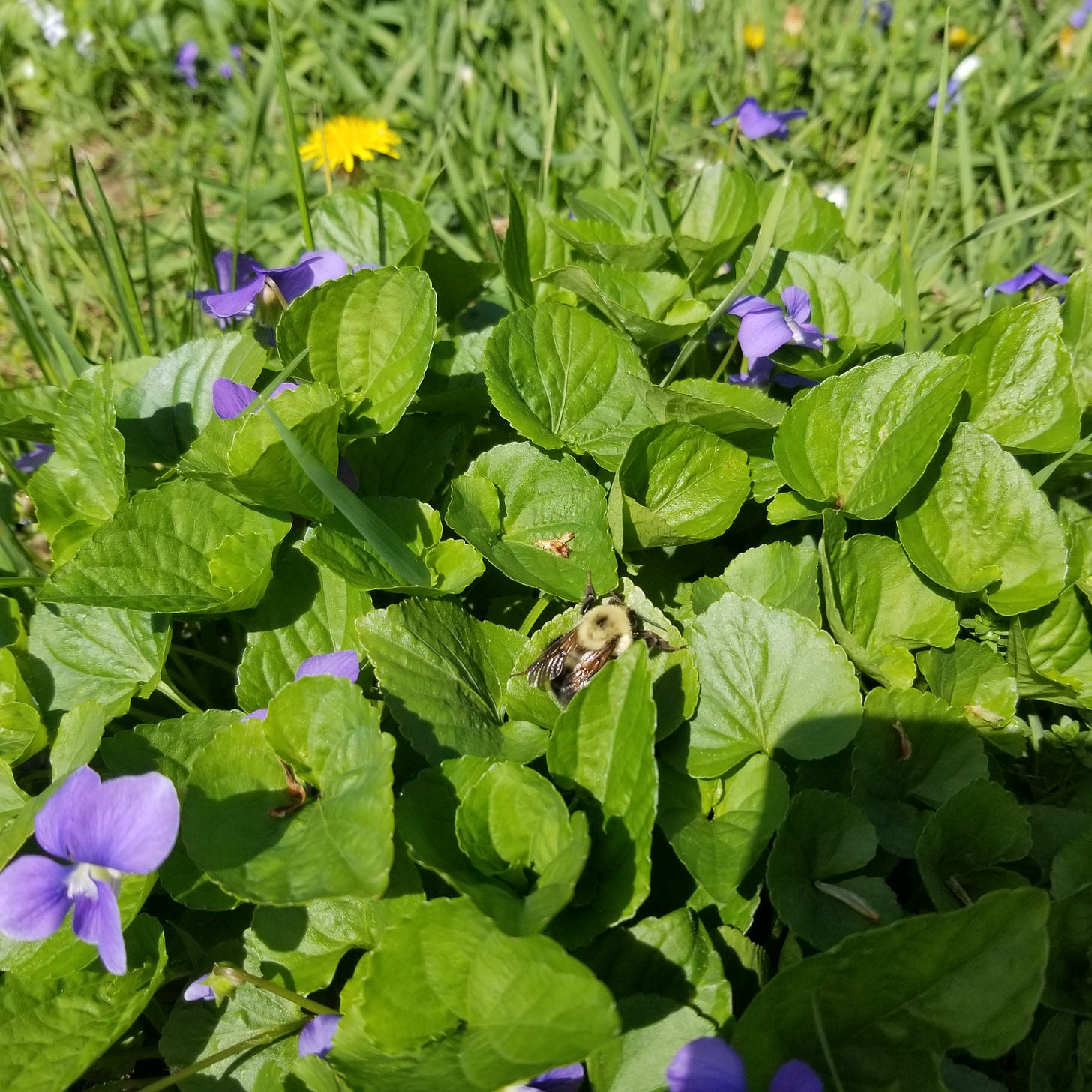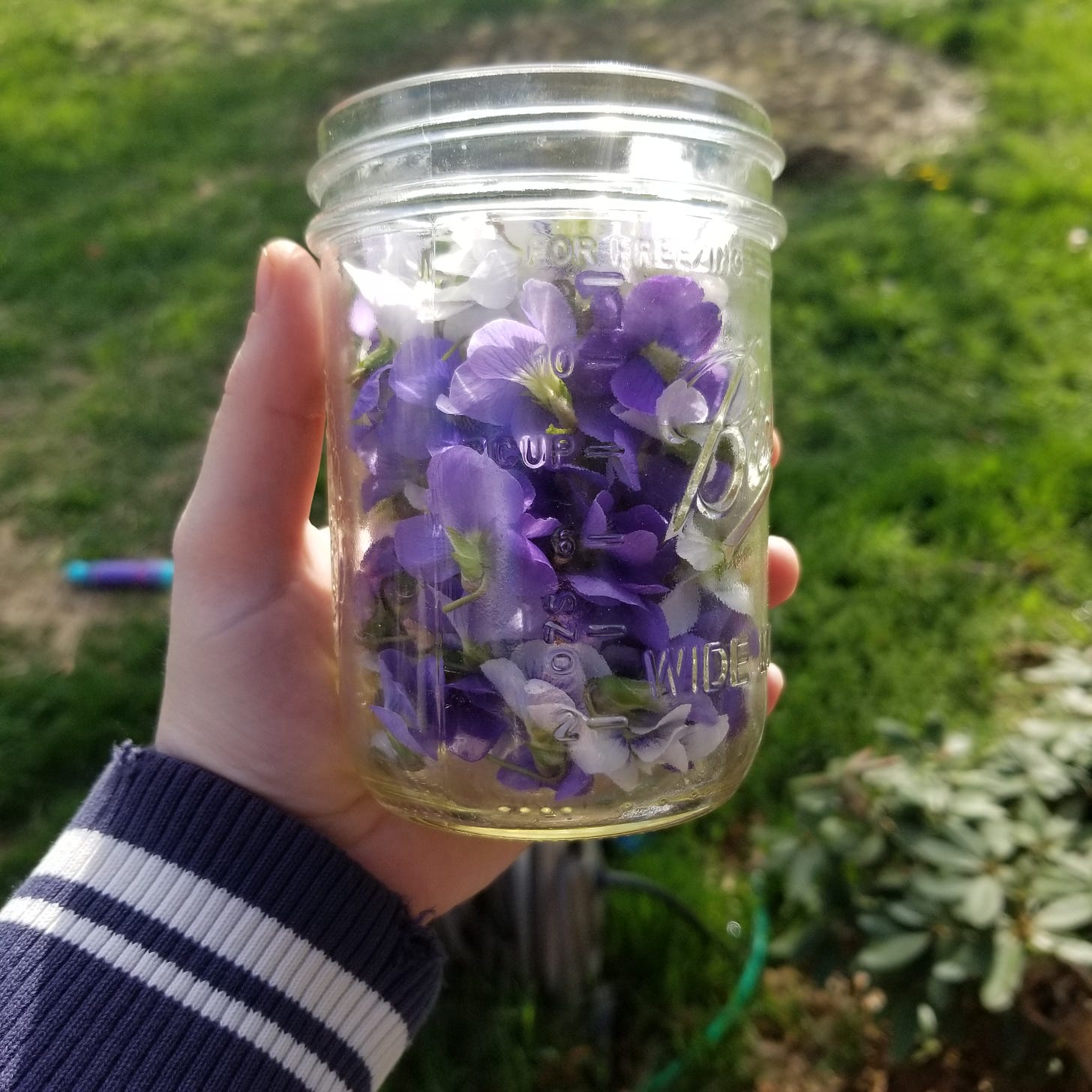Wild Violets Are For Detoxing
When sore throats, colds, and fevers happen, I skip the pharmacy and visit the backyard instead.
Wild violets are one of my favorite early spring beauties, those little stars of purple and white that glitter under the morning sun in coats made of fresh dew.
After the vernal equinox, my daughter and I wait patiently for the violets to begin opening, knowing that — not far behind those delicate blooms — the bumblebees will begin waking.
As we’re rounding out the first week of No-Mow May, and the first bumblebees have appeared (including one that needed rescuing from our screened-in porch), I’ve made my second* wild harvest of the season:
Wild violets.
While I’ve always appreciated wild violets for putting out flowers when the other plants seemed to be hibernating, it was only recently that I learned how powerful wild violets are for healing.
The piddly bits . . .
1. Subscribe or update your subscription!
Choose the Books & Bullshit you actually want to receive. Life’s too short for clutter. To choose, go to: https://booksandbullshit.substack.com/account
2. Join The Novel Nest!
Subscribe to the editorially focused Novel Nest monthly newsletter and receive invites to our close-knit writers group here:
3. Fancy a visit to my writing craft shop?
To grab your copy of Point of View: A Guide to Perspective in Fiction & Memoir, download a printable Purpose Roadmap to jumpstart your writing, or outline your story at the scene level using my Story Planning guide, visit my shop:
Now, moving on . . .
Wild Violets Are Food For Bees, Bunnies, and Humans
There are no more perfect symbols of spring than bumblebees and baby bunnies. Bumblebees love violets for the nectar, and I’ve spent afternoons watching bunnies nibble violet greens for the hydration and nutrition.
Most of the gardeners I know, myself included, look forward to spring greens: Arugula, watercress, and collards. But many folks overlook the bounty of fresh spring greens that just appear in our yards every season, of which wild violets are but one variety.
Wild violets are best harvested in the morning before the sun gets too hot and the flowers begin to wilt.
Both the leaves and flowers of wild violets are edible**. The younger leaves and flowers are soft and tender and make for great salad additions. The older leaves can be cooked in soups and stews or steamed to tenderize them and neutralize any bitterness.
But if all you can reasonably do is violently yank a handful of violet flowers and leaves from the ground in sheer rapture, throw those babies in a salad, dress as normal, and enjoy.
Just remember to check for little bugs hiding in the blooms first.
Wild Violets Are Powerhouse Medicinals That Don’t Get Enough Credit
Since turning to a terrain-based lifestyle, emptying my life of Big-Pharma intervention, and seizing control over my health and wellness to great benefit, I’ve learned to lean into plant medicines, “folk” remedies. And while in my younger years I’d have laughed at those old-fogey recipes, I know understand just how much folk remedies truly matter for overall human health.
Frankly, it’s strange that more people trust Big Pharma to whip them up yet another chemical cocktail than trust themselves to brew their own cup of healing tea, or make their own balms, tinctures, and infusions.
Why throw ever more at multi-billion-dollar corporations who don’t know us, don’t care about us, and need us to remain ill so we can be good customers? Anyhoo . . .
When used medicinally, wild violets help the body detoxify, strengthen the immune system, and stimulate lymphatic drainage. They can also reduce imflammation, soothe the bronchial passages, and work as an expectorant — a well-rounded clearer-outer of gook.
From sore throats, to colds, to sinus infections, whooping and dry hacking coughs, inflammation, arthritis and joint pain, scrapes and bruises, to hemorrhoids, to dermatitis, to insect bites, wild violets do it all.
Some folks are allergic to violets, but reactions are few and far between when used correctly.
Wild Violet Tea For the Win
As far as folk remedies go, you almost can’t go wrong with the right tea. Teas can be ingested, of course, for a number of ailments and maladies, but (unsweetened) wild violet tea can also be applied externally as a wash to treat skin conditions and irritation.
The flowers freshly picked this morning will be dried and preserved for tea, so my family can enjoy these health benefits year-round.
To make a basic wild violet tea, you can either use all flowers (if you have enough) or a 2:1 leaves-to-flowers blend if you’re short on blossoms.
To your mug, add:
2 teaspoons of dried wild violet leaves plus 1 tsp of dried wild violet flowers OR 2 teaspoons of dried wild violet flowers
1 cup of boiling water
raw honey (optional to taste, but skip if making tea for external use)
Allow the tea to steep for about five minutes. Then strain the tea and drink.
Wild violet tea can be safely given to children, too. My daughter even eats a fresh blossom here and there as a “yard snack.”
So, what’s your favorite way to use wild violets?
Footnotes
*The first wild harvest of the season was fresh yarrow greens, which I infused into an oil, blended with calendula-infused oil and beeswax, and turned into Boo-Boo Balm, a year-round staple for us.
**The roots and seeds of wild violets are not edible. They may cause nausea and vomiting, so stay away!
Related Articles on Healing:
Food Is Medicine
I’m not sure I learned proper nutrition until I was pregnant with my kiddo and had a wicked craving for raisin-bran cereal. I love me some raisin bran, but the power of that craving was out of this world. I was consumed by it, couldn’t stop thinking about raisin bran. So, I went out and got a box of bran flakes with raisins. Then, I called my best frien…











I love this. It makes me want to go out and eat violets!